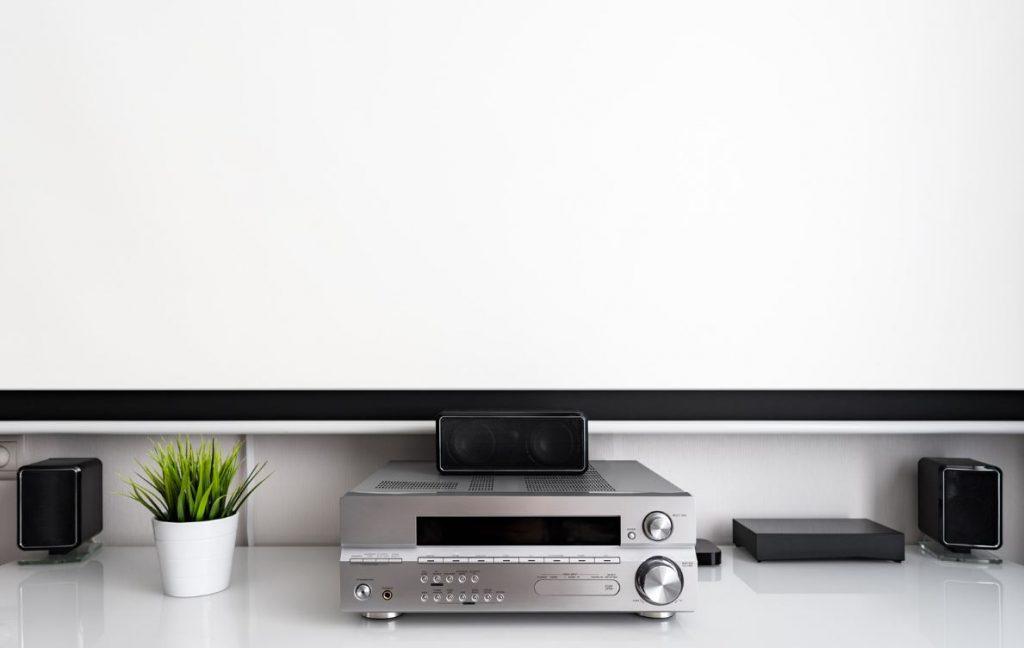Home Sound System Installation Tips
A sound system can spectacularly improve your audio experience at home. For proper home sound system installation, you should turn to professionals.
In today’s post, we’ve prepared some tips to further help with your home sound system installation project and improve the performance and efficiency of your home sound system.
Choose the Ideal Room
Square or rectangular rooms don’t do anything for acoustics or sound quality. In short, those types of rooms are not suitable for it. Sound system experts advise homeowners to pick a room in their house close to width 1.5 times the height of the room, while the length is 2.5 times the room height. This is the type of room that can produce optimal sounds when it comes to home theater.
Additionally, avoid hard or rigid surfaces that can reflect audio waves. Installing carpet in your home media room can also dramatically improve the acoustics, so does placing the right type of home theater furniture.
If your listening space is smaller, common sense dictates that you can’t use larger sound systems; they may be too potent for your space. This doesn’t necessarily mean bigger is better. Home sound systems are customizable. We’re sure you can find something in the market that can suit your space.
In fact, smaller spaces can have the best audio quality. Because of the limited space, sound waves don’t have to travel as far. They can reflect back much faster, resulting in crisper and clearer sounds.
The key takeaway is not just to get the first thing you see or go super cheap that you’re compromising sound quality. For expert recommendations, you can turn to home sound system installation forums – or, better yet, reach out to professionals.
Proper Positioning of Speakers
Home audio experts recommend that all speakers should be at about an adult’s head height when you’re sitting down and facing towards the listening position. Also, a good rule of thumb to follow is to place the back of the speaker a monimum of one foot away from any wall. This is the ideal distance from the wall not to create any boundary overload.

The pair of speakers at the front, along with the central speaker, must be at the same distance from your listening angle. Many speaker models can be raised to make up for not following this specific guideline. We’ll discuss that more in a separate post.
Another home sound system installation and placement tip to come in mind is about the position of the surround speakers. They should be on opposite sides of your listening angle. Additionally, if you have a 7.1 sound system, the rear sounds must be behind the listening angle.
When it comes to the subwoofers, you have more freedom positioning it anywhere in the room. The massive bass sound waves are capable of filling the entire room no matter the angle.
Calibration of Speakers
Home theater receivers are accompanied by a microphone, along with a program or software for calibrating the speakers. A well-calibrated speaker system can produce immersive and balanced audio throughout the room. Home sound system installation experts know how to do proper speaker calibration.
The speakers must be calibrated to compensate for mediocre and insufficient room size and poor speaker positioning.
Utilize Surround Sound Formats – and Only Use the Best
Lossless and lossy are audio formats. The former is less compressed. They have all the data from the source studio track, so lossless formats sound crisper and better, compared to the lossy formats.
DTS and Dolby both come in those two types of audio formats. When it comes to using the best format, opt for either the DTS-HD Master or the Dolby TrueHD. These two surround sounds have uncompressed formats that can produce optimum sound for your home.
Equipment Upgrade

For right now, you may be pleased and satisfied with your home sound system installation. However, you should always consider upgrading your equipment down the road.
This is especially true if you had a stricter budget when you purchased your first home sound system. Let’s face it: elite and top-of-the-line speakers and receivers are unmatched.
If you have to either upgrade your speakers or receivers (and you can only pick one), opt for the speakers.
Speakers consist of up to a minimum of 75 percent of audio quality. Amplifiers and other sound system components comprise the rest of the 25 percent. Thus, it’s obvious here that you must place more weight in upgrading the speakers, above any other component in your sound system.



